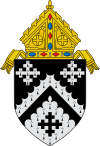
Sacred Heart Cathedral, located in Davenport, Iowa, United States, is a Catholic cathedral and a parish church in the Diocese of Davenport. The cathedral is located on a bluff overlooking the Mississippi River to the east of Downtown Davenport. It is listed on the National Register of Historic Places as part of the Sacred Heart Roman Catholic Cathedral Complex. This designation includes the church building, rectory, and the former convent, which was torn down in 2012. The cathedral is adjacent to the Cork Hill Historic District, also on the National Register. Its location on Cork Hill, a section of the city settled by Irish immigrants.
Saint Anthony Catholic Church in Honolulu is a parish in the West Honolulu Vicariate Forane of the Roman Catholic Diocese of Honolulu.

The Diocese of Biloxi is a Latin Church ecclesiastical territory, or diocese, of the Catholic Church that encompasses 17 counties in southern Mississippi in the United States. The diocese was erected on March 1, 1977, when it was split from the Diocese of Jackson. The Diocese of Biloxi is a suffragan diocese of the ecclesiastical province of the metropolitan Archdiocese of Mobile, though for its first three years the diocese was in the province of the Archdiocese of New Orleans.

The Diocese of Cleveland is a Latin Church ecclesiastical territory, or diocese, of the Catholic Church in northeastern Ohio in the United States. As of September 2020, the bishop is Edward Malesic. The Cathedral of St. John the Evangelist, located in Cleveland, is the mother church of the diocese.

St. Mary Star of the Sea Catholic Church is a parish of the Roman Catholic Church located in downtown Jackson, Michigan, in the Diocese of Lansing. It is dedicated to Our Lady, Star of the Sea. In 2008 it absorbed the congregations of St. Stanislaus Kostka Chapel and the Chapel of Sacred Heart, also in Jackson.

Sacred Heart Catholic Church was constructed in 1905 in downtown Tampa, Florida and is one of the oldest churches in the city of Tampa. The church, located at 509 N. Florida Avenue, is predominantly a Romanesque structure, with other elements. The church is home to Sacred Heart Parish, part of the West Hillsborough Deanery of the Roman Catholic Diocese of Saint Petersburg.

The Shrine Church of St. Stanislaus is the home of a Catholic parish within the Diocese of Cleveland. St. Stanislaus is one of the major historic centers of Polish life in Cleveland, Ohio, especially for Poles with roots in Warsaw and surrounding areas, and is often called the mother church for Cleveland's Polish population. The shrine is located at the intersection of Forman Ave. and East 65th St., in a part of the South Broadway neighborhood previously known as Warszawa; today the area is known as Slavic Village. The church, the neighborhood, and the larger surroundings are GNIS named features.
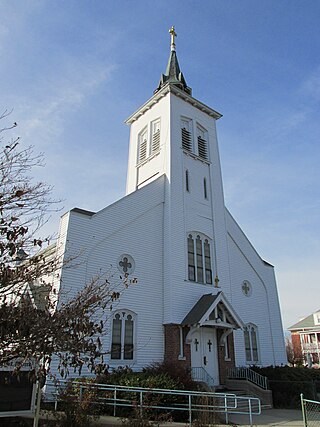
Sacred Heart of Jesus Parish - designated for Polish immigrants in Easthampton, Massachusetts, United States. It was founded in 1909. It is one of the Polish-American Roman Catholic parishes in New England in the Diocese of Springfield in Massachusetts. It closed in June 2010.

The Basilica of the Sacred Heart of Jesus is a Roman Catholic church in downtown Atlanta, Georgia, United States. The current building, at the intersection of Peachtree Street and Peachtree Center Avenue, was completed in 1898. It was added to the National Register of Historic Places in 1976 and was designated a minor basilica in 2010.

Saint Irenaeus Church is a former parish of the Diocese of Davenport. The church was founded in the town of Lyons, which now the north side of Clinton, Iowa, United States. It has been listed on the National Register of Historic Places since 2010.
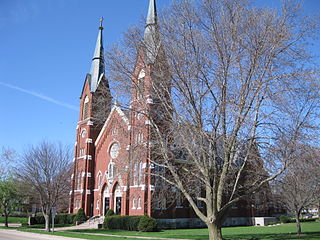
St. Boniface Church is a former parish church of the Diocese of Davenport. The church was founded in the town of Lyons, which is now the north side of Clinton, Iowa, United States. The church building is now a museum named The Catholic Historical Center at St. Boniface, with exhibits about the history of the Clinton area Catholic community, and an archive of local Catholic church artifacts and records. The church was listed on the National Register of Historic Places in 2012.

St. Mary's on the Flats, originally known as the Church of Our Lady of the Lake, was the first Catholic church building in Cleveland, Ohio. The location where the church once stood can be found, in an 1881 atlas, at the south-east corner of Columbus Ave. and then Girard Ave. on the east bank of the Cuyahoga river in the flats. Irishtown Bend Archeological District, where many of the parishioners lived, lies to the west, across the Cuyahoga river in what was Ohio City. Ohio City was annexed by Cleveland on June 5, 1854.
Immaculate Heart of Mary Church, is a Catholic parish church in Cleveland, Ohio and part of the Diocese of Cleveland. It is a located on Lansing Ave. near East 66th St., in a part of the South Broadway neighborhood previously known as Warszawa, also referred to today as Slavic Village. Both the church and the area are GNIS named features. The church is in the neighborhood of, but not within, the area listed as Warszawa Neighborhood District on the National Register of Historic Places. The church, school, rectory, and convent buildings are listed together as a Cleveland Designated Landmark.
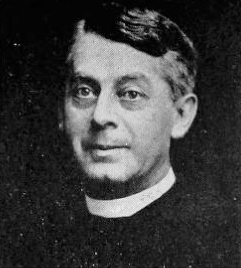
George Francis Houck was Chancellor of the Roman Catholic Diocese of Cleveland from 1882 to 1908. He also wrote Volume One of the 1903 A History of Catholicity in Northern Ohio and the Diocese of Cleveland from 1749 to December 31, 1900, an overview history of Roman Catholicism in northern Ohio beginning with Catholic missions in the American frontier of the Ohio Country, one of the first settled parts of the Midwestern United States, and concluding with a history of the Cleveland diocese through the end of the 19th century.
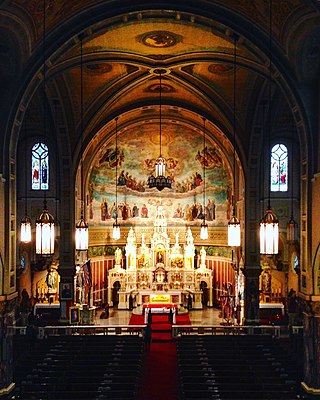
Saint Casimir Church is a Catholic parish church in Cleveland, Ohio, and part of the Roman Catholic Diocese of Cleveland. It is designated "a personal parish for those Catholics of the Latin Rite of Polish descent" in Cleveland. A personal parish is designated under Canon 518 of the 1983 Code of Canon Law. It is located at the north-east corner of intersection of East 82nd St. and Sowiniski Ave., in a part of the St. Clair-Superior neighborhood previously known in Polish as na Poznaniu.
St. Peter Church, is a Catholic parish church in Cleveland, Ohio and part of the Diocese of Cleveland. Founded in 1853, it is located at the intersection of Superior Ave. near East 17th St., in the Downtown neighborhood.
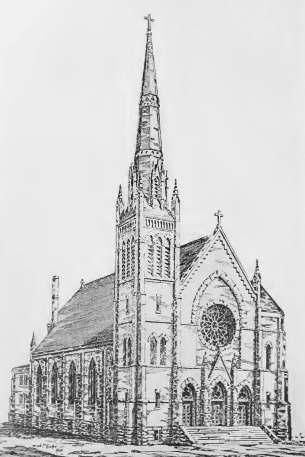
Annunciation Church (historic) (French: Église de l'Annonciation de Cleveland), was a Catholic parish church in Cleveland, Ohio and part of the Diocese of Cleveland. It was located at the intersection of Hurd St. and Moore St., now part of the West Side Market parking lot, in the Ohio City neighborhood. The location where the church once stood can be found, in an 1881 atlas, at the south-west corner of Hurd St. and Moore St., on the west bank of the Cuyahoga river above part of the Flats historically known as Ox Bow Bend. It was located about 1,560 ft (480 m) walking distance from St. Mary's on the Flats, the first Catholic church in Cleveland and about 150 ft (46 m) distance from the present St. Emeric Church.
Transfiguration Church, was a Catholic parish church in Cleveland, Ohio, in the United States. Part of the Roman Catholic Diocese of Cleveland, it was located at the southwest corner of the intersection of Broadway Avenue and Fullerton Avenue in a part of the South Broadway neighborhood previously known in Polish as Warszawa, also referred to today as Slavic Village. The church suffered a severe structure fire in 1990. The parish closed in 1992, and the church was demolished in early 1993. The records of this church, and all churches closed after 1975, can be found in the Catholic Diocese of Cleveland Archives. Diocesan policy is to keep all archive records closed.















